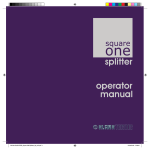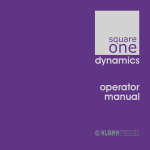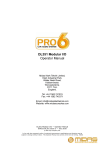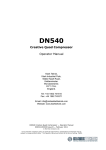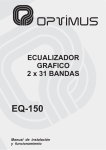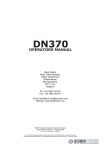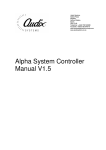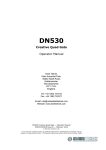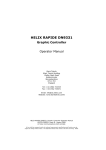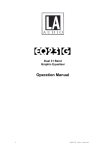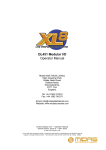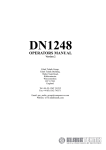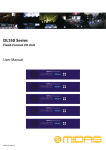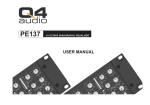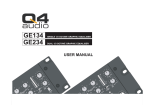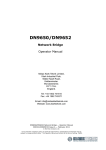Download Square ONE Graphic
Transcript
graphic operator manual DOC02-SQ1GRAPHIC_Op_IssE_printdata.pdf 1 27/04/2010 10:06:44 DOC02-SQ1GRAPHIC_Op_IssE_printdata.pdf 2 27/04/2010 10:06:44 graphic OPERATOR MANUAL Midas Klark Teknik Limited Klark Industrial Park Walter Nash Road Kidderminster Worcestershire DY11 7HJ England Tel: +44 1562 741515 Fax: +44 1562 745371 Email: [email protected] Website: www.ktsquareone.com Square ONE Graphic Equaliser — Operator Manual DOC02-SQ1GRAPHIC Issue E — April 2010 © Red Chip Company Ltd. In line with the company’s policy of continual improvement, specifications and function may be subject to change without notice. This Operators Manual was correct at the time of writing. E&OE. DOC02-SQ1GRAPHIC_Op_IssE_printdata.pdf 3 27/04/2010 10:06:44 DOC02-SQ1GRAPHIC_Op_IssE_printdata.pdf 4 27/04/2010 10:06:44 IMPORTANT SAFETY INSTRUCTIONS The lightning flash with arrowhead symbol within an equilateral triangle, is intended to alert the user to the presence of uninsulated “Dangerous Voltage” within the product's enclosure that may be of sufficient magnitude to constitute a risk of electric shock to persons. 1 Read these instructions. 2 Keep these instructions. 3 Heed all warnings. 4 Follow all instructions. 5 Do not use this apparatus near water. 6 Clean only with a dry cloth. 7 Do not block any of the ventilation openings. Install in accordance with the manufacturer’s instructions. 8 Do not install near any heat sources such as radiators, heat registers, stoves, or other apparatus (including amplifiers) that produce heat. 9 10 Do not defeat the safety purpose of the polarized or grounding-type plug. A polarized plug has two blades with one wider than the other. A grounding type plug has two blades and a third grounding prong. The wide blade or the third prong are provided for your safety. If the provided plug does not fit into your outlet, consult an electrician for replacement of the obsolete outlet. Protect the power cord from being walked on or pinched particularly at plugs, convenience receptacles, and the point where they exit from the apparatus. DOC02-SQ1GRAPHIC_Op_IssE_printdata.pdf 5 The exclamation point within an equilateral triangle, is intended to alert the user to the presence of important operating and maintenance (servicing) instructions in the literature accompanying the product. 11 Only use attachments/accessories specified by the manufacturer. 12 Unplug this apparatus during lightning storms or when unused for long periods of time. 13 Refer all servicing to qualified personnel. Servicing is required when the apparatus has been damaged in any way, such as power supply cord or plug is damaged, liquid has been spilled or objects have fallen into the apparatus, the apparatus has been exposed to rain or moisture, does not operate normally, or has been dropped. 14 Use the mains plug to disconnect the apparatus from the mains. 15 Warning: To reduce the risk of fire or electric shock, do not expose this apparatus to rain or moisture. 16 Do not expose this equipment to dripping or splashing and ensure that no objects filled with liquids, such as vases, are placed on the equipment. 17 The mains plug of the power supply cord shall remain readily operable. 27/04/2010 10:06:44 DOC02-SQ1GRAPHIC_Op_IssE_printdata.pdf 6 27/04/2010 10:06:44 Klark Teknik EC-Declaration of Conformity The undersigned, representing the following manufacturer Manufacturer: Address: Midas Klark Teknik Limited Klark Industrial Park, Walter Nash Road, Kidderminster, Worcestershire DY11 7HJ hereby declares that the following product Product Type Number Product Description Nominal Voltage(s) Current Freq. Square ONE Graphic Graphic Equaliser 115V AC 230V AC 314mA 155.2mA 50/60Hz is in conformity with the regulations of the following marked EC-directive(s) and bears the accordingly Reference Number Title 2004/108/EC EMC Directive (EMC) 2006/95/EC Low-Voltage Directive (LVD) -mark The conformity of the product with EC Directives for use in environments E1, E2, E3 and E4 is provided by the compliance with the following standards: Standards/date Reference Number Title EN50081/1 Generic Standard Using EN55103 Limits and Methods EN55103 Class B Conducted Emissions PAVI EN55103 Class B Radiated Emissions PAVI EN61000-3-3:2000 Voltage Fluctuation and Flicker EN61000-3-2:1995 Harmonic Current Emissions EN60065:2002 Electrical Safety Place, date: Kidderminster, UK 15th April 2010 General Manager Printed name: John Oakley DOC02-SQ1GRAPHIC_Op_IssE_printdata.pdf 7 AVP, Product Development Printed name: Alex Cooper 27/04/2010 10:06:44 DOC02-SQ1GRAPHIC_Op_IssE_printdata.pdf 8 27/04/2010 10:06:44 Page i Contents Welcome! __________________________________________ 1 Safety precautions ___________________________________ 2 Safety warnings General precautions Power Handling the equipment Installation Location Audio connections Radio frequency interference 2 2 3 3 4 4 4 4 Class B device 4 Electric fields Operation Safety equipment Optional equipment Special accessories 5 5 5 5 5 Unpacking Checking the mains fuse Installation Connecting the power cable Connecting the audio cables 7 7 7 7 8 Features ___________________________________________ 6 Getting started______________________________________ 7 Balanced I/O Unbalanced I/O Unbalanced inserts Connecting to unbalanced equipment 8 8 9 10 Powering up the unit 10 Signal level Graphic EQ section Gain control Filters BYPASS switch POWER on/off LED 13 13 13 14 14 14 Front panel quick reference ___________________________ 11 Rear panel quick reference ___________________________ 12 Front panel features ________________________________ 13 Square ONE Graphic DOC02-SQ1GRAPHIC_Op_IssE_printdata.pdf 9 i 27/04/2010 10:06:44 Rear panel features _________________________________ 15 Mains supply Audio connections 15 16 Audio inputs Audio outputs 16 16 Power-off bypass relays 16 Studio and creative use Live use - front of house (FOH) Live use - monitors 18 18 19 Preparing for equalisation Equalisation using an RTA 20 20 Effects of equalisation on voice reproduction Effects of equalisation on music reproduction 22 23 Other features _____________________________________ 16 Example of system connection_________________________ 17 Using the Square ONE Graphic_________________________ 18 Equalising a system _________________________________ 20 Effects of equalisation _______________________________ 22 Audio signal path ___________________________________ Proportional-Q filter response _________________________ Balanced/unbalanced audio __________________________ Square ONE Graphic application notes___________________ Front-of-house Monitors High pass filter (HPF) Low pass filter (LPF) Technical specification_______________________________ Frequency chart ____________________________________ Crib sheet_________________________________________ Service information _________________________________ Routine maintenance Cleaning the unit Checking/replacing the mains fuse 31 31 31 31 32 33 34 35 35 35 35 ii DOC02-SQ1GRAPHIC_Op_IssE_printdata.pdf 10 24 25 30 31 Square ONE Graphic 27/04/2010 10:06:44 Welcome! Welcome! Thank you for purchasing a Klark Teknik Square ONE Graphic graphic equaliser. Klark Teknik has conceived the Square ONE range to offer audio professionals a range of easily accessible, high-performance audio equipment, designed to provide no-compromise sonic quality with a feature set which offers all essential facilities. Your Square ONE Graphic equaliser represents the very best of British design and engineering, combined with contemporary, efficient manufacturing methods, and will give you many years of reliable service. The Square ONE Graphic is a dual, 30-band, third octave graphic equaliser. It incorporates long throw 45 mm faders and has high and low pass filters on each channel. All backed up, of course, by the standard Klark Teknik three year warranty. Please take the time to complete and return the registration card or fill in the Warranty Registration Form online by visiting our website at www.ktsquareone.com and, to obtain the best results with a minimum of effort, also read this operators manual. Finally, enjoy your Klark Teknik Square ONE Graphic! Square ONE Graphic DOC02-SQ1GRAPHIC_Op_IssE_printdata.pdf 11 1 27/04/2010 10:06:44 Safety precautions Safety precautions Before installing, setting up or operating this equipment please ensure that you have read and fully understand all of this section and the “IMPORTANT SAFETY INSTRUCTIONS” at the front of this manual. This equipment is supplied by a mains voltage that can cause electric shock injury! The following special limitations must be observed in order to maintain safety and electromagnetic compatibility performance. Safety warnings This equipment is fitted with a 3-pin power socket. For safety reasons the earth lead must not be disconnected. Signal 0V is connected internally to the chassis. To completely disconnect this equipment from the AC mains, unplug the mains lead from the power outlet. Do not expose this equipment to dripping or splashing and ensure that no objects filled with liquids, such as vases, are placed on the equipment. To prevent shock or fire hazard, do not expose the equipment to rain or moisture. To avoid electrical shock do not remove covers. Refer servicing to qualified personnel only. The power supplies - even the DC ones - have a high current! General precautions The following information gives basic safety precautions that should be observed to reduce the risk of fire, electric shock and personal injury: • Only properly trained service personnel familiar with this manual and with the generally applicable safety regulations should service the equipment. • Safety instructions detailed in the manual should be understood and properly implemented. • In the event of ground loop problems, disconnect the signal screen at one end of the connecting cables. Note that this can only be done when the equipment is used within a balanced system. • Never operate damaged equipment and never operate equipment with damaged cables. • Any part that is damaged should be properly repaired or replaced. This must be done by a fully trained and authorised service engineer. • Observe all warnings, cautions etc. on any part of the equipment. • Do not remove, hide or deface any warnings or cautions. 2 DOC02-SQ1GRAPHIC_Op_IssE_printdata.pdf 12 Square ONE Graphic 27/04/2010 10:06:44 Safety precautions Power THE POWER SUPPLY SHOULD NEVER BE OPERATED WITH THE MAINS EARTH DISCONNECTED! This unit should only be operated with the power supply connected to ground via the ground in the mains connector. The internal power supply is a switch mode type that automatically senses the incoming mains voltage and will work where the nominal voltage is in the range 100-240 VAC. A single, fused IEC mains inlet is provided on the rear panel. The correct lead for connection in the area to which the unit was shipped is supplied with the unit. The equipment should only be plugged into the mains outlet using the supplied lead. Please note that the power supply contains LETHAL VOLTAGES greatly in excess of the mains voltage and that its rails can produce extremely large currents that could burn out equipment and wiring if shorted. All testing and servicing must ONLY be carried out by approved service engineers. We strongly recommend that, for safety and to optimise the life and performance of the equipment, the mains cable plug is removed from the power outlet when the equipment is not to be used for extended periods of time or during electrical storms. When removing the equipment’s electric plug from an outlet, always hold the plug itself and not the cable. Pulling out the plug by the cable can damage it. Never insert or remove an electric plug with wet hands. Handling the equipment Completely isolate the equipment electrically and disconnect all cables from the equipment before moving it. When lifting or moving the equipment, take its weight into consideration. Do not insert your fingers or hand in any gaps or openings on the equipment, for example, vents. Avoid inserting or dropping foreign objects, such as paper, plastic, metal etc., into any gaps or openings on the equipment, for example, vents. If this happens, turn off the power immediately and unplug the power from the AC outlet. Then have the equipment inspected by the manufacturer's qualified service personnel. Square ONE Graphic DOC02-SQ1GRAPHIC_Op_IssE_printdata.pdf 13 3 27/04/2010 10:06:44 Safety precautions Installation Before installing the equipment: • Make sure the equipment is correctly connected to the protective earth conductor of the mains voltage supply of the system installation through the mains lead. • Power to the equipment must be via a fused spur. • The power plug must be inserted in a socket outlet provided with a protective earth contact. The electrical supply at the socket outlet must provide appropriate over-current protection. • Both the mains supply and the quality of earthing must be adequate for the equipment. • Before connecting up the equipment, check that the mains power supply voltage rating corresponds with the local mains power supply and that the mains fuse is of the correct type and rating. • Ideally a cool area is preferred not in close proximity to power distribution equipment or other potential sources of interference. • Do not install the equipment in places of poor ventilation. • Do not install this equipment in a location subjected to excessive heat, dust or mechanical vibration. Allow for adequate ventilation around the equipment, making sure that its fans and vents are not obstructed. To prevent excessive heating of the equipment, avoid mounting it directly above power amplifiers or other devices that radiate significant amounts of heat such as, radiators and heaters. Keep the equipment out of direct sunlight. Where necessary use fan cooled racks. • Do not place equipment in an unstable condition where it might accidentally fall over. • Make sure that the mains voltage and fuse rating information of the equipment will be visible after installation. • Do not use the equipment in the vicinity of electrical devices, such as computer monitors or mobile phones, which may generate electrical noise. Location Audio connections To ensure the correct and reliable operation of your Square ONE Graphic, only high quality balanced, screened, twisted pair audio cable should be used. XLR connector shells should be of metal construction so that they provide a screen when connected to the unit and should have Pin 1 connected to the cable screen. Radio frequency interference Class B device This equipment has been tested and found to comply with the limits for a Class B digital device, pursuant to part 15 of the FCC Rules. These limits are designed to provide reasonable protection against harmful interference in a residential installation. This equipment generates, uses, and can radiate radio frequency energy and, if not installed and used in accordance with the instructions, may cause harmful interference to 4 DOC02-SQ1GRAPHIC_Op_IssE_printdata.pdf 14 Square ONE Graphic 27/04/2010 10:06:44 Safety precautions radio communications. However, there is no guarantee that interference will not occur in a particular installation. If this equipment does cause harmful interference to radio or television reception, which can be determined by turning the equipment off and on, the user is encouraged to try to correct the interference by one or more of the following measures: • Reorient or relocate the receiving antenna. • Increase the separation between the equipment and receiver. • Connect the equipment into an outlet on a circuit different from that to which the receiver is connected. • Consult the dealer or an experienced radio TV technician for help. Electric fields Caution: In accordance with Part 15 of the FCC Rules & Regulations, “… changes or modifications not expressly approved by the party responsible for compliance could void the user's authority to operate the equipment.” Should this product be used in an electromagnetic field that is amplitude modulated by an audio frequency signal (20Hz to 20kHz), the signal to noise ratio may be degraded. Degradation of up to 60dB at a frequency corresponding to the modulation signal may be experienced under extreme conditions (3V/m, 90% modulation). Operation To avoid electrical shock, never operate the equipment with the covers removed. Safety equipment Never remove, for example, covers, housings or any other safety guards. Do not operate the equipment or any of its parts if safety guards are ineffective or their effectiveness has been reduced. Optional equipment Unless advised otherwise, optional equipment must only be installed by service personnel and in accordance with the appropriate assembly and usage regulations. Special accessories To comply with part 15 of the FCC Rules, any special accessories (that is, items that cannot be readily obtained from multiple retail outlets) supplied with this equipment must be used with this equipment; do not use any alternatives as they may not fulfil the RF requirement. Square ONE Graphic DOC02-SQ1GRAPHIC_Op_IssE_printdata.pdf 15 5 27/04/2010 10:06:44 Features Features The Square ONE Graphic 1/3 octave, analogue equaliser performs graphic equalisation and filtering, and has the following features: • Two channels. • 30 bands of proportional-Q equalisation per channel via long throw, 45 mm faders. • Electrically balanced input and output per channel via female and male XLR connectors, respectively. • 1/4” TRS-balanced jack socket for each input and output. • Level metering per channel is provided by SIGNAL and CLIP LEDs. • Gain control per channel for continuous adjustment of channel gain. • Fixed 80Hz high pass filter per channel. • Fixed 12kHz low pass filter per channel. • Input gain, filters and graphic equalisation on each channel can be bypassed. • Power-off bypass relays to avoid audible thumps when unit is switched off or if a power rail fails. • Pushbutton switch operation for high and low pass filters and bypass. • LEDs for power, high and low pass filters, and bypass that provide on/off status indication. • Mains supplied via an IEC socket on rear panel. • Fuse drawer contains easily replaceable mains fuse with a compartment for a spare. 6 DOC02-SQ1GRAPHIC_Op_IssE_printdata.pdf 16 Square ONE Graphic 27/04/2010 10:06:44 Getting started Getting started Observing the guidelines in “Safety precautions” on page 2, carry out the following to get your Square ONE Graphic unit fully operational. Unpacking Carefully unpack your Square ONE Graphic equipment package. Then please inspect the Square ONE Graphic unit carefully for any signs of damage that may have occurred during transit and notify the courier immediately if you discover any. Check the contents of your Square ONE Graphic equipment package. If there are any parts missing, incorrect or faulty, please contact your local distributor or Klark Teknik at the address at the front of this manual. Please retain the original packing in case you should need to return the equipment to the manufacturer or supplier, or transport or ship the unit later. Checking the mains fuse Before installing the equipment you need to make sure that the mains fuse fitted is of the correct type and rating for your unit. To do this follow the instructions in “Checking/replacing the mains fuse” on page 35. Installation This unit is designed for mounting in any 19” EIA standard rack. Four rack-mount holes in the front panel are provided for rack mounting and are designed to fully support the weight of the unit in the rack. The position of the unit will depend upon how it is to be used. However, when positioning the unit, avoid placing it where the faders may be damaged by being accidentally knocked or snapped off. Also, try to avoid placing the unit directly near or on any power distribution units or power amplifiers. Connecting the power cable Making sure that the mains power at the power outlet is off, connect the mains cable supplied with your Square ONE Graphic to the mains power outlet and then to the mains socket at the rear of your unit. Square ONE Graphic DOC02-SQ1GRAPHIC_Op_IssE_printdata.pdf 17 7 27/04/2010 10:06:45 Getting started Connecting the audio cables This section gives the connection details for balanced/unbalanced I/O and unbalanced inserts. For more details on balancing, see “Balanced/unbalanced audio” on page 30. Balanced I/O For balanced I/O, connect the audio cables as shown below. Male XLR 1 Pin 1: Screen/Ground 2 Female XLR 2 3 1 Pin 1: Screen/Ground 3 Pin 3: Cold signal Pin 3: Cold signal Pin 2: Hot signal Pin 2: Hot signal Unbalanced I/O For unbalanced I/O, connect the audio cables as shown below. Male XLR 1 Pin 1: Screen/Ground (not connected at unbalanced end) 2 2 3 1 Pin 1: Screen/Ground (not connected at unbalanced end) 3 Pin 3: Ground at unbalanced end Pin 3: Ground at unbalanced end Pin 2: Hot signal 8 DOC02-SQ1GRAPHIC_Op_IssE_printdata.pdf 18 Female XLR Pin 2: Hot signal Square ONE Graphic 27/04/2010 10:06:45 Getting started Unbalanced inserts For unbalanced inserts, connect the audio cables as shown in Figure 2, below. Figure 1 shows the construction of a 1/4” TRS connector. Sleeve: ground/shield Tip: send (out) Strain relief clamp Ring: return (in) Note: Connect insert send with input and insert return with output of effects device. Figure 1: Insert send/return 1/4” TRS connector details Tip Ring Sleeve Tip Sleeve Tip Sleeve Tip (send) Sleeve (ground/shield) Tip Ring Sleeve Tip (return) Sleeve (ground/shield) Figure 2: Insert send/return 1/4” TRS connectors - wiring details Square ONE Graphic DOC02-SQ1GRAPHIC_Op_IssE_printdata.pdf 19 9 27/04/2010 10:06:45 Getting started Connecting to unbalanced equipment Ideally, you will be making the best use of the Square ONE Graphic’s low-noise high-headroom balanced inputs by connecting to similarly balanced equipment. However, if you do have to connect to unbalanced devices, the following wiring is recommended for best results (see Figure 3): • Connect the +ve (pin 2) of the balanced connection to the +ve terminal on the unbalanced connector. • Connect the -ve (pin 3) of the balanced connection to the common (ground) terminal on the unbalanced connector. • Connect the ground (pin 1) of the balanced connection, to the common (ground) terminal on the unbalanced connector. Male XLR Ring Tip Sleeve Female 1 Tip 3 2 Male XLR Ring 2 Sleeve 3 1 Female XLR Figure 3: Insert send/return 1/4” TRS connector/XLRs - wiring details Powering up the unit To power up the unit, switch on the power at the mains power outlet. The POWER LED on the front of the unit will illuminate to indicate that power is on. Your unit is now ready to operate. 10 DOC02-SQ1GRAPHIC_Op_IssE_printdata.pdf 20 Square ONE Graphic 27/04/2010 10:06:45 Front panel quick reference Front panel quick reference The Klark Teknik Square ONE Graphic is a dual, 30-band, third octave graphic equaliser. Low pass filter switch with LED on/off indicator (above) Channel A BYPASS filter switch with LED on/off indicator (above) 45 mm faders +12 +12 0 GAIN - -12 -12 6 BYPASS 80 12k A SIGNAL CLIP graphic +12 POWER B +12 0 GAIN - -12 Channel B 6 BYPASS 80 12k -12 Level metering with SIGNAL and CLIP LED on/off indicators GAIN rotary control knob High pass filter switch with LED on/off indicator (above) POWER on/off indicator: illuminates to show power is on Square ONE Graphic DOC02-SQ1GRAPHIC_Op_IssE_printdata.pdf 21 11 27/04/2010 10:06:45 Rear panel quick reference Rear panel quick reference RISK OF ELECTRIC SHOCK DO NOT OPEN WARNING: TO REDUCE THE RISK OF ELECTRIC SHOCK, DESIGNED AND ENGINEERED IN ENGLAND DO NOT EXPOSE THIS APPLIANCE TO RAIN OR MOISTURE AVIS: RISQUE DE CHOC ELECTRIQUE. NE PAS OUVRIR. ASSEMBLED IN CHINA NO USER SERVICEABLE PARTS INSIDE. REFER SERVICING TO QUALIFIED SERVICE PERSONNEL. CAUTION: FOR CONTINUED PROTECTION AGAINST RISK OF FIRE REPLACE WITH THE SAME TYPE AND VALUE FUSE INDICATED. ATTENTION: REMPLACER PAR UN FUSIBLE DE MÊME TYPE COMME INDIQUÉ. THIS DEVICE COMPLIES WITH PART 15 OF THE FCC RULES. OPERATION IS SUBJECT TO THE FOLLOWING CONDITIONS: (1) THIS DEVICE MAY NOT CAUSE HARMFUL INTERFERENCE, AND (2) THIS DEVICE MUST ACCEPT ANY INTERFERENCE RECEIVED, INCLUDING INTERFERENCE THAT MAY CAUSE UNDESIRED OPERATION. OUTPUT B SUPPLY VOLTAGE INPUT B R C US OUTPUT A INPUT A PUSH 100-240V AC~50-60Hz 25W FUSE: 5x20mm T800mA L250V PUSH TO REDUCE RISK OF FIRE, REPLACE WITH SAME TYPE OF FUSE. MOUNT IN RACK ONLY B Mains power socket and fuse compartment Channels A and B: input and output audio connections, comprising a male and a female XLR socket each with a 1/4”, TRS-balanced jack socket 12 DOC02-SQ1GRAPHIC_Op_IssE_printdata.pdf 22 A Square ONE Graphic 27/04/2010 10:06:45 Front panel features Front panel features The Klark Teknik Square ONE Graphic is a dual-channel, 30-band, third octave analogue graphic equaliser. In addition to the graphic equaliser itself, high and low pass filters are provided per channel and an equaliser in/ out switch to bypass the effect of the equaliser and filter stages. Power is supplied to the unit via the rear panel; an LED on the front panel provides power on/off indication. Signal level The Square ONE Graphic provides a SIGNAL and a CLIP LED per channel for the purpose of level metering. The levels are as follows: • SIGNAL (Green): -40dBu • CLIP (Red): +20dBu SIGNAL LED (green): illuminates to show the input signal has exceeded -40dBu. The signal is pre-EQ (but post-gain control). A SIGNAL CLIP B CLIP LED (red): illuminates to show the maximum output level of the unit has been achieved, that is, +20dBu has been exceeded, and the unit has entered clipping. This LED is sourced post-EQ (and post-gain control) such that internal clipping due to excessive EQ, that is, if a high input level is further boosted by the use of EQ, will also be shown. Graphic EQ section The graphic EQ section of the Square ONE Graphic features long throw 45 mm faders to allow fine adjustment of each frequency band. Each fader has a centre detent (’click stop’) to denote the 0dB (unity gain of the band) point of the scale. The Square ONE Graphic uses standard ISO third octave standard frequency centres. +12 The range of the faders is ±12dB. Placing the fader of any band at the extreme upwards position will apply 12dB gain to the frequencies in that band. While, conversely, placing the fader of any band at the extreme downwards position will apply 12dB attenuation to the frequencies in that band. -12 Gain control 0 GAIN - The gain control provides continuous adjustment of the channel gain from minus infinity (off) to +6dB with a centre detent at 0dB (unity gain). When using EQ with large amounts of cut or boost, it may be necessary to use the gain to make up or attenuate the signal. 6 Square ONE Graphic DOC02-SQ1GRAPHIC_Op_IssE_printdata.pdf 23 13 27/04/2010 10:06:45 Front panel features Filters The high and low pass filters on each channel both have an on/off pushbutton switch and yellow LED that illuminates to indicate that the filter is in operation. Both filters are fixed and have a 12 dBu/octave roll-off characteristic. The corner frequencies of the filters, that is, 80Hz on the high pass filter and 12kHz on the low pass filter, have been selected to match the typical low- and high-end responses, respectively, of monitor wedges in applications where they are being driven full-range to aid intelligibility and allow higher gain before feedback. To audition the effect of the filters, just switch them on or off and note the effect. LEDs for on/off filter indication BYPASS filter pushbutton bypasses any active filters High pass filter pushbutton cuts off frequencies below 80Hz Low pass filter pushbutton cuts off frequencies above 12kHz BYPASS switch Each channel has BYPASS pushbutton on/off switch with red LED that illuminates to indicate a bypass condition. When switched on, the BYPASS switch bypasses the input gain and graphic equalisation. POWER on/off LED The blue POWER LED on the front panel illuminates to indicate that mains power is applied to the unit. The unit does not have a power on/off switch. 14 DOC02-SQ1GRAPHIC_Op_IssE_printdata.pdf 24 Square ONE Graphic 27/04/2010 10:06:45 Rear panel features Rear panel features The rear panel provides the power and audio connections to the Square ONE Graphic. You will also find important information, such as warnings and cautions, power supply and fuse specifications, safety and compliance standards markings etc., printed on the rear panel. Mains supply Mains power is supplied to the Square ONE Graphic by a fused IEC socket on the rear of the unit. The Square ONE Graphic contains an auto voltage sensing switching mode power supply that will operate where the nominal mains voltage is in the range 100VAC to 240VAC. The correct mains lead for the country to which the unit was shipped is supplied with the unit. The mains fuse is located in a fuse drawer, directly underneath the mains socket. The drawer has two compartments, the rear containing the working fuse while the front provides room for a spare. Always replace the mains fuse with the same type and rating; see “Checking/replacing the mains fuse” on page 35 for details. IEC socket Supply voltage and fuse specifications Fuse warning information Fuse drawer Square ONE Graphic DOC02-SQ1GRAPHIC_Op_IssE_printdata.pdf 25 15 27/04/2010 10:06:45 Other features Audio connections Audio input and output connections to the two channels, A and B, are electronically balanced and clearly labelled. The audio connections for channel B are shown below; please refer to “Audio connections” on page 4 for pin assignments. Channel B Female XLR - input Male XLR - output 1/4” TRS, balanced jack socket - output 1/4” TRS, balanced jack socket - input Audio inputs The audio inputs comprise two parallel connected, series AA, female XLR chassis connectors and two 1/4” TRS, balanced jack sockets. Audio outputs The audio outputs comprise two parallel connected, series AA, male XLR chassis connectors and two 1/4” TRS, balanced jack sockets. Other features Power-off bypass relays The Square ONE Graphic incorporates a fail-safe hardware bypass to prevent audible thumps when the unit is switched off or if any of its internal power rails should fail. The bypass comprises relays that directly connect the inputs and outputs of each channel. The relays disconnect the outputs and switch to bypass every time the unit is switched off or on power rail failure. On power up, the unit waits for about one second before the relays are switched. This gives enough time for the power rails to rise and the circuits to stabilise to allow normal operation of the unit. 16 DOC02-SQ1GRAPHIC_Op_IssE_printdata.pdf 26 Square ONE Graphic 27/04/2010 10:06:45 Example of system connection Example of system connection EQUALISER X-Over & Amplifiers EQUALISER X-Over & Amplifiers Centre Cluster Delay FoH Delay FoH Main FOH Main FOH Stage Monitors EQUALISER X-Over & Amplifiers X-Over & Amplifiers Monitor Console Delay Line FOH Console Square ONE Graphic DOC02-SQ1GRAPHIC_Op_IssE_printdata.pdf 27 17 27/04/2010 10:06:45 Using the Square ONE Graphic Using the Square ONE Graphic The Square ONE Graphic is a graphic equaliser that utilises premium quality, low tolerance components to achieve a high degree of accuracy and control. Graphic equalisers may be used for corrective or creative purposes depending upon whether they are to be used live - as monitors or for front of house FOH - or in the studio for broadcasting or recording. Studio and creative use In the control room, a graphic equaliser may be used to remove problem frequencies and improve deficiencies in room acoustics. This is commonly achieved with the use of a real time analyser (RTA). As the frequency centres of the Square ONE Graphic conform to ISO standards, corrections can be made by sight directly from the RTA to the graphic. However, it is important to mention that graphic equalisers can only compensate a limited amount for a room with severe acoustic problems, in which case further remedial treatment work may be required. Graphic equalisers can only help to reduce the audible effects of standing waves and resonances and cannot overcome the loss of clarity due to rooms with long reverberation times. The Square ONE Graphic can be used to create filter effects, for example, the effect of someone speaking on the telephone, using the 30 equaliser bands and the high and low pass filters in conjunction with a compressor to create a de-esser for tonal correction of instruments or vocals and many other creative uses. Live use - front of house (FOH) It is often desirable to add equalisation to a venue to remove any frequency deficiencies in the room before trying to engineer using the system. Again, it is common to use an RTA and measurement microphone to set up the equaliser using additive and subtractive equalisation to correct problems in the room. It is recommended to attenuate peaks in the room’s response to the level of the surrounding frequencies rather than boost the lower bands to meet the highest. This will help to retain headroom in the equaliser and slight dips in frequency response are less noticeable than large peaks. If an overall reduction in volume is observed, the gain make-up can be used to return the output of the equaliser to the desired level. However, please beware of excessive equalisation by, for example, using large amounts of boost at lower frequencies to compensate for poorly performing bass enclosures. This will use up large amounts of system headroom that could cause the system amplifiers to clip, thus damaging loudspeaker HF components and introducing high frequency harmonics, which may sound unpleasant. Using large amounts of low frequency boost may also cause the over-excursion of bass drivers and result in their mechanical and electrical breakdown. Also, many sound reinforcement systems are only capable of adequately producing frequencies up to around 18kHz. Providing high levels of boost at 20kHz to extend the frequency response of the system is likely to result in a reduction in the life of high frequency components in the loudspeaker, while not achieving a significant improvement in the frequency response. There are occasions where deficiencies in room acoustics cannot be corrected by equalisation. For example, bass reduction due to phase cancellation or the cancellation around the crossover point of a loudspeaker must be corrected before the use of equalisation. 18 DOC02-SQ1GRAPHIC_Op_IssE_printdata.pdf 28 Square ONE Graphic 27/04/2010 10:06:45 Using the Square ONE Graphic Live use - monitors Monitors used on stage often need equalisation to remove any peaks in their frequency response in order to prevent feedback from on-stage microphones where those frequencies exceed the maximum gain before feedback level. Further equalisation may be required to remove similar peaks from the characteristics of the microphones in use. A monitor engineer may use an RTA to detect these peaks but, more often than not, monitor engineers have a developed sense of hearing that enables them to remove these frequencies by ear. The Square ONE Graphic’s 30 EQ bands allow a majority of feedback to be removed from the monitors. High and low pass filters are provided that can be used to remove high frequency feedback and bass rumble or over-excursion of bass drivers. It may also be undesirable to have large amounts of bass in the on-stage monitors. In vocal monitors, bass does not assist projection of vocals and can make the stage sound unbearable, hence, the bass element can be rolled off at the desired frequency. The fundamentals of vocals are transmitted in a narrow audible range and will appear unaffected. Square ONE Graphic DOC02-SQ1GRAPHIC_Op_IssE_printdata.pdf 29 19 27/04/2010 10:06:45 Equalising a system Equalising a system As discussed before, the fundamental benefits of equalisation are: • Improved intelligibility and natural sound of the sound system. • An increase in the gain available in the system before feedback. In some circumstances, it may not be possible to achieve a natural sounding system that is completely intelligible due to poor acoustics or high levels of background noise. In such cases, a compromise must be struck by the engineer depending upon the use to which the system will be put. It may be argued that in the case of a vocalist, intelligibility must be sought at all costs. However, for dance music reproduction a more natural approach, with no real concern for intelligibility of the individual lyrics, may be preferred. Please remember, the equaliser is not a ‘cure all’ device and will not solve the problems of a poor sound system, installation or venue acoustics but, when used carefully, can bring out significant improvements in the quality of reproduction of a system. Preparing for equalisation Before starting to equalise the system, it is worthwhile checking that the system is performing correctly. Listening to the system without any equalisation may reveal underlying distortion or artefacts of the room, for example, lengthy reverberation, which may need to be rectified before trying to equalise the room. It may also be worthwhile using a sine tone sweep so that problems at certain frequencies, which may not be immediately noticeable with pink noise, can be detected and corrected before equalisation. Especially, check the system’s crossover points as these may reveal problems with the system. Note that poor coverage cannot be rectified through the use of equalisation. When you are satisfied with the basic system performance, equalisation can begin. Equalisation using an RTA The measurement microphone should, ideally, have a flat response or be calibrated to the RTA and placed in a sensible position where it will not be affected by nearby objects that may interfere with the local acoustics, such as within one metre of a rear or side wall, or in a balcony opening. Using the RTA and a pink noise source, adjust the level of the frequency bands on the graphic equaliser inversely to that shown on the RTA display. Do it so that the peaks in frequency response are reduced to the level of the other bands and, conversely, the deficient bands are increased. You will need to perform the test at a reasonable level approaching normal usage volume so that the equalisation can take into account the response of the loudspeakers at normal operating level (versus low level). It may also be desirable to take measurements at points throughout the area. Although it may not be possible to get perfect equalisation throughout an entire area, it may be preferable to obtain a good equalisation of the whole area rather than a perfect equalisation at a single point with poor performance at all other points. A compromise may need to be made in an effort to equalise the sound for the whole area rather than just the centre FOH position. 20 DOC02-SQ1GRAPHIC_Op_IssE_printdata.pdf 30 Square ONE Graphic 27/04/2010 10:06:45 Equalising a system EQUALISER CALIBRATED MEASUREMENT MICROPHONE Note: When using an RTA, ensure that it has averaging capability so that fluctuations are smoothed out giving a good representation of the sonic performance of the system. l ab c PINK NOISE REAL TIME ANALYSER When equalising the room, bear in mind the effect upon the electronics and mechanics of the system caused by the equalisation process. If excessive equalisation is required at certain bands, consider the effect upon amplifier headroom and loudspeaker driver excursion that will result. It may not be possible to produce the response required within the limitations of the system. Excessive equalisation should act as a warning that there may be an underlying problem which may need rectifying first, for example, phase cancellation, blown drivers etc. During the performance, the FOH or monitor engineer may want to have a microphone or solo signal feed for the RTA so that feedback may be easily detected and rectified. Square ONE Graphic DOC02-SQ1GRAPHIC_Op_IssE_printdata.pdf 31 21 27/04/2010 10:06:46 Effects of equalisation Effects of equalisation Effects of equalisation on voice reproduction 1/3 Octave Centre Frequency Effect On Voice 40, 50, 63, 80, 100, 125 Sense of power in some outstanding bass singers. 160, 200, 250 Voice fundamentals. 315, 400, 500 Important for voice quality. 630, 800, 1k Important for voice naturalness. Too much boost in the 315 to 1k range produces a telephone-like quality. 1k25 to 4k Vocal fricatives. Accentuation and clarity of voice. Important to speech intelligibility. Too much boost between 2kHz and 4kHz can mask certain speech sounds, for example, ‘m’, ‘b’ and ‘v’, which can become indistinguishable. Too much boost anywhere between 1kHz and 4kHz can produce listener fatigue. Vocals can be highlighted by slightly boosting vocals at 3kHz whilst simultaneously slightly cutting instruments at that frequency. 5k, 6k3, 8k Accentuation and clarity of voice. 10k, 12k5, 16k Too much boost causes sibilance (’sss’). 22 DOC02-SQ1GRAPHIC_Op_IssE_printdata.pdf 32 Square ONE Graphic 27/04/2010 10:06:46 Effects of equalisation Effects of equalisation on music reproduction 1/3 Octave Centre Frequency 31, 40, 50, 63 Effect On Music Fundamentals of bass drum, tuba, bass and organ. These give music a sense of power but excessive use can leave the sound ‘muddy’. Mains Hum (50-60Hz). 80, 100, 125 Too much boost produces ‘boom’. (Fundamentals of tympani and toms.) Higher harmonics of mains hum (100-120Hz). 160, 200, 250 Drum and lower bass. Too much boost produces ‘boom’. 3rd Harmonics of Mains Hum. 315, 400, 500 Fundamentals of strings and percussion. 630, 800, 1k Fundamentals and harmonics of strings, keyboards and percussion. Boosting 600-1kHz range can make instruments sound horn-like. 1k25 to 4k Drums, guitar, accentuation of vocals, strings and brass. Excessive boost around 1-2kHz can make instruments sound ‘tinny’. Excessive boost around 1-4kHz can produce ‘listening fatigue’. 5k, 6k3, 8k Accentuation of percussion, cymbals and snare drum. Reduction at 5kHz makes overall sound more distant and transparent. Reduction of tape hiss and system noise. 1k25 to 8k governs overall clarity and definition. 10k, 12k5, 16k Cymbals and overall brightness. Too much boost causes sibilance. Reduction of tape hiss and system noise. Square ONE Graphic DOC02-SQ1GRAPHIC_Op_IssE_printdata.pdf 33 23 27/04/2010 10:06:46 Audio signal path Audio signal path The following diagram shows the path of the audio signal for each channel. BYPASS Switch -40dBu +22dBu High pass filter Low pass filter Graphic EQ Graphic EQ PUSH Input Two stages 80 Switch 12k Switch 24 DOC02-SQ1GRAPHIC_Op_IssE_printdata.pdf 34 Output Square ONE Graphic 27/04/2010 10:06:46 Proportional-Q filter response Proportional-Q filter response The most important design decision for the Square ONE Graphic was determining the equaliser response. Proportional-Q equalisation, as used on previous Klark Teknik analogue graphic equalisers, offers some key advantages over the more numerous Constant-Q equalisers on the market. Namely, at low amounts of cut or boost, the width of the filter is relatively broad and becomes narrower as the amount of boost or cut is increased, giving a more 'focused' response. This differs from a Constant-Q response, which boosts or cuts an increasingly wide band of frequencies. This is an important consideration in applications, such as cutting particular problem frequencies, as more of the frequency spectrum is scooped out when using Constant-Q equalisation. Whereas, Proportional-Q equalisers are much better at cutting just the problem frequency band. On Constant-Q equalisers the Q is measured 3dB up from the point of maximum attenuation when in cut, rather than the correct definition of 3dB down from the point of maximum gain (0dB when cutting), which results in a notch filter response. In all types of graphic equalisers, one of the key issues is how the summing of adjacent EQ bands alters the frequency response. Lower-Q filters will blend together more smoothly, but higher-Q filters provide more selective control of problems - at the expense of more frequency response ripple. A weakness of the Constant-Q approach is that for small amounts of boost and cut (a very typical situation), the EQ bands have to be comparatively broad to blend smoothly so as to avoid excessive ripple in the frequency response. However, as the Q of the EQ bands remains constant, larger amounts of boost or cut will affect an increasingly wide range of frequencies, thus limiting the precision and usefulness of the equaliser. Figure 4 and Figure 5 show the responses of a leading Constant-Q equaliser in both its 'wide' and 'narrow' modes of operation for 2dB of boost and cut, which is typical of the small adjustments made in corrective EQ applications. The 'wide' response gives a very smooth combined response for the three bands shown. However, the 'narrow' response shows significant ripple in the combined response which will lead to audible artefacts such as phase distortion. Square ONE Graphic DOC02-SQ1GRAPHIC_Op_IssE_printdata.pdf 35 25 27/04/2010 10:06:46 Proportional-Q filter response +15 +10 +5 d B u +0 -5 -10 -15 300 400 500 600 700 800 900 1k 2k 3k 4k 2k 3k 4k Hz Figure 4: Constant-Q equaliser ‘wide’ mode ±2dB boost and cut +15 +10 +5 d B u +0 -5 -10 -15 300 400 500 600 700 800 900 1k Hz Figure 5: Constant-Q equaliser ‘narrow’ mode ±2dB boost and cut While the 'wide' response is obviously preferable for small amounts of boost and cut, Figure 6 and Figure 7 show the problem that occurs with using this response for full boost and cut. Here, far more of the audio spectrum is affected due to each band being broader as a consequence of maintaining the same Q value. 26 DOC02-SQ1GRAPHIC_Op_IssE_printdata.pdf 36 Square ONE Graphic 27/04/2010 10:06:46 Proportional-Q filter response +15 +10 +5 d B u +0 -5 -10 -15 300 400 500 600 700 800 900 1k 2k 3k 4k 2k 3k 4k Hz Figure 6: Constant-Q equaliser ‘wide’ mode full boost and cut +15 +10 +5 d B u +0 -5 -10 -15 300 400 500 600 700 800 900 1k Hz Figure 7: Constant-Q equaliser ‘narrow’ mode full boost and cut The advantage of Proportional-Q equalisation is that the EQ bands are wider at lower amounts of boost and cut. They become narrower as greater amounts are applied, thus giving the optimum balance of smoothness Square ONE Graphic DOC02-SQ1GRAPHIC_Op_IssE_printdata.pdf 37 27 27/04/2010 10:06:46 Proportional-Q filter response and accuracy over the entire fader travel. Extensive listening tests were carried out during the development of the Square ONE Graphic to obtain the optimum response. This has resulted in a very musical sounding equaliser that maintains the highest level of accuracy without ever sounding harsh. Figure 8 and Figure 9 show the Square ONE Graphic responses for both 2dB and full scale boost and cut. Note that the smooth combining of the bands for small amounts of boost and cut is very similar to that of the Constant-Q equaliser in its 'wide' mode. However, as more boost or cut is applied the response becomes sharper, giving much more precise control of problem frequencies. +15 +10 +5 d B u +0 -5 -10 -15 300 400 500 600 700 800 900 1k 2k 3k 4k Hz Figure 8: Square ONE Graphic response ±2dB boost and cut 28 DOC02-SQ1GRAPHIC_Op_IssE_printdata.pdf 38 Square ONE Graphic 27/04/2010 10:06:46 Proportional-Q filter response +15 +10 +5 d B u +0 -5 -10 -15 300 400 500 600 700 800 900 1k 2k 3k 4k Hz Figure 9: Square ONE Graphic response full boost and cut In addition to the graphic equaliser section, the Square ONE Graphic also provides high pass and low pass filters. These can be used to enhance the intelligibility of wedge monitors by cutting out extraneous low and high frequency noise and therefore allowing higher SPLs to be used. Square ONE Graphic DOC02-SQ1GRAPHIC_Op_IssE_printdata.pdf 39 29 27/04/2010 10:06:46 Balanced/unbalanced audio Balanced/unbalanced audio Balancing refers to the type of input or output signal connections in an audio system. These connections are specifically designed to reject external noise, for example, from mains wiring, and internal interference from adjacent signal cables. Unlike unbalanced lines, which are more susceptible to noise, balancing is especially useful when long cable runs are used between pieces of equipment and can also provide other benefits, including an increase in line signal level and a decreased possibility of ground loops. Balanced connections are typically employed on long cable runs, for example, to amplifiers, or for cables carrying sensitive or low level signals, for example, mics. A balanced line typically employs connectors of the XLR and 1/4” TRS jack plug types. The basic principle of balanced interconnection is the cancelling out of any electrical noise by means of a three-cable connection to achieve the required signal. Two of the cables, called “hot” and “cold”, are used to carry signals and the third is a grounded shield that surrounds the hot and cold cables. (An unbalanced connection only has two cables, one of which, the grounded shield, is also used for signal return.) As the hot and cold cables are of equal voltage (and the same source impedance) but of opposite polarity, when they are subtracted, any noise voltages - caused by interference and noise pick-up - appearing identically on both cables is cancelled out; the difference between them being the resultant signal. However, in practice the electrical noise on both cables will never be identical, and the degree to which it is reduced is measured by the common mode rejection ratio (CMRR). The electronically balanced input and output connections of the Square ONE Graphic have the benefit of high common mode rejection (CMR), which eliminates externally induced interference such as mains hum etc. CMR is the ability of a balanced input to reject the part of the incoming signal that has the same amplitude and opposite phase on both input terminals, referenced to ground. As a specification, CMR is usually stated as a dB ratio, called CMRR, at a given frequency. Note: On balanced circuits, the ‘hot’ signal is also known as “+ve” and “in phase”, while the ‘cold’ signal is also known as “-ve” and “out of phase”. 30 DOC02-SQ1GRAPHIC_Op_IssE_printdata.pdf 40 Square ONE Graphic 27/04/2010 10:06:46 Square ONE Graphic application notes Square ONE Graphic application notes Front-of-house The graphic EQ filters of the Square ONE Graphic have been carefully selected to allow tonal correction with a minimum of ripple between adjacent bands. While, at the same time the proportional-Q nature of the filters ensures that in the event of acoustic feedback a tightly-focussed cut response is instantly available just by moving the fader. The ±12dB, 45 mm long-throw faders provide superb control resolution and excellent visibility of control settings. The high and low-pass filters allow the frequency extremes to be matched to the capabilities of the loudspeaker system in use, leaving all the graphic EQ faders available for acoustic management of the music. Positive in/out switching for all the filter sections is combined with LEDs to give instant ‘at a glance’ status indication. Monitors The design of the graphic filters with carefully selected Proportional-Q responses ensures that problem frequencies can be attenuated quickly and effectively. Long-throw faders allow excellent control resolution even when using all of the available 12dB of attenuation. Interaction with adjacent bands is minimised, ensuring that more of the musical content is preserved. The filter pushbutton switches allow the filters to be switched easily in and out, for example, when an artist is using different instruments during a show. LEDs above the filter pushbuttons ensure that the filter status is always visible at a glance. High and low pass filters allow the frequency limits to be accurately controlled for each output. This last feature, while very useful for conventional wedge monitors, really comes into its own when combining in-ear and wedge monitors, allowing the response of each monitor subsystem to be tailored to the artist’s requirements. High pass filter (HPF) High pass filters (HPFs) on graphic equalisers are used to remove unwanted subsonic frequencies (traditionally about 30Hz). The HPF on the Square ONE Graphic is set at 80Hz. If using your Square ONE Graphic with a large speaker system, you will almost certainly be using an active crossover, which should provide appropriate subsonic protection. In this case, leave the HPF out of circuit. When using more compact loudspeakers, use the 80Hz knee of the Square ONE Graphic’s HPF for maximising their headroom and efficiency. If using your Square ONE Graphic with monitor (foldback) loudspeakers that have an extended bass response, the HPF can still be used; in fact, useful results can be obtained by “bending” the knee of the HPF by boosting the 63Hz fader on the Square ONE Graphic. Low pass filter (LPF) The Square ONE Graphic’s low pass filter (LPF) is fixed at 12kHz. This is optimal for stage monitoring applications - both loudspeaker and in-ear monitor (IEM) systems - and will increase available headroom as well as providing high frequency (HF) drivers with some thermal protection against ultrasonic frequencies. When engaged simultaneously, the Square ONE Graphic’s HPF and LPF give optimal control of the operating bandwidth of most foldback (floor wedge and IEM) transducer systems. Square ONE Graphic DOC02-SQ1GRAPHIC_Op_IssE_printdata.pdf 41 31 27/04/2010 10:06:46 Technical specification Technical specification Inputs Two (A and B) Type Impedance Maximum input level Common mode rejection Outputs Two (A and B) Type Minimum load impedance Source impedance Maximum output level Signal drive capability Performance Frequency response Dynamic range Noise floor Gain ±0.5dBu (input to output), 20Hz to 20kHz >112dB (22Hz to 22kHz unweighted) Lower than -90dBu (22Hz to 22kHz unweighted) -infinity (off) to +6dBu, with centre detent at 0dB Equalisation 30 Bands Centre Frequencies Tolerance Maximum Boost/Cut High Pass Filter Slope Low Pass Filter Slope To BS EN ISO 266:1997 25Hz to 20kHz, 1/3 octave ±5% ±12dB 12dB/octave 12dB/octave Terminations Audio Analogue, electronically balanced (Pin 2 hot) 20k Ohms +22dBu >80dB at 1kHz, >60dB at 10kHz Analogue, electronically balanced (Pin 2 hot) 2k Ohms <60 Ohms +22dBu <3dB drop in level relative to open circuit voltage when driving 200 Ohms Power 3-pin XLRs (male and female) and 1/4” TRS balanced jack sockets 3-pin IEC Power Requirements Voltage Frequency Consumption 100VAC to 240VAC ±10% 50Hz to 60Hz <25W Dimensions Height Width Depth 133 mm (5.25”), 3U high 483 mm (19”) 200 mm (7 7/8”) Weight Net Shipping 4.4 kg 5.4 kg BS EN ISO 266:1997 Frequency Centres: The ISO standard frequencies (Hz): 25, 31.5, 40, 50, 63, 80, 100, 125, 160, 200, 250, 315, 400, 500, 630, 800, 1.00k, 1.25k, 1.60k, 2.00k, 2.50k, 3.15k, 4.00k, 5.00k, 6.30k, 8.00k, 10.0k, 12.5k, 16.0k, 20.0k Due to a policy of continual improvement, Klark Teknik reserves the right to alter the function or specification at any time without notice. 32 DOC02-SQ1GRAPHIC_Op_IssE_printdata.pdf 42 Square ONE Graphic 27/04/2010 10:06:46 Frequency chart Frequency chart 12 12 # b C E # # b # F G B C E b # # 20k 16k 12k5 8k 10k 5k 6k3 4k 3k15 2k 2k5 1k6 1k 1k25 800 630 500 400 315 250 200 160 125 80 100 63 50 40 25 12 31.5 (Hz) 12 b F G B C D E F G A B C D E F G A B C PIANO LARGE PIPE ORGAN VIOLIN VIOLA CELLO DOUBLE BASS PICCOLO FLUTE OBOE BASSOON TRUMPET Note: This information is provided as a rough guide to the range of fundamental frequencies used by various common instruments. In addition to these, various amounts of higher harmonic content will also be produced. TROMBONE TUBA SOPRANO CONTRALTO BARITONE BASS SNARE & TOMS BASS DRUM DRUM KIT (BASS DRUM/SNARE+TOMS) GUITAR Square ONE Graphic DOC02-SQ1GRAPHIC_Op_IssE_printdata.pdf 43 20k 16k 12k5 8k 10k 6k3 5k 4k 3k15 2k 2k5 1k6 1k 1k25 Square 1 Graphic LOW PASS FILTER 800 630 500 400 315 250 200 160 125 80 100 63 50 40 31.5 25 (Hz) Square 1 Graphic HIGH PASS FILTER 33 27/04/2010 10:06:47 Crib sheet Crib sheet +12 +12 0 GAIN - graphic -12 -12 +12 +12 6 BYPASS A SIGNAL CLIP B 80 12k POWER 0 GAIN - -12 6 BYPASS 80 12k BYPASS 80 12k -12 Location: Date: Application: +12 +12 0 GAIN - graphic -12 -12 +12 +12 6 A SIGNAL CLIP B POWER 0 GAIN - -12 6 BYPASS 80 12k -12 Location: Date: Application: 34 DOC02-SQ1GRAPHIC_Op_IssE_printdata.pdf 44 Square ONE Graphic 27/04/2010 10:06:47 Service information Service information The service manual for this equipment is available for purchase. Please contact your local distributor for details. Routine maintenance To help keep your Square ONE Graphic unit in good working order and to make sure it gives you optimum performance, we recommend that you carry out the following about once every month: • Clean the unit, as detailed in “Cleaning the unit” on page 35. • Check controls for freedom of operation. As the controls are ‘self-cleaning’, this operation will help to prevent them from sticking. • Check functionality of all controls, that is, faders, pushbuttons, LEDs etc. • Check functionality of equipment. Cleaning the unit Switch off the unit and electrically isolate it from the mains before cleaning. Clean the unit using a dry, lint-free cloth. Do not use harsh abrasives or solvents. When cleaning the unit, take great care not to damage faders, pushbuttons etc. Checking/replacing the mains fuse The equipment must be independently isolated from the mains voltage supply before any attempt is made to change or check the protective fuse. The fuse and its cover must always be replaced before the equipment is reconnected to the mains voltage supply. Only use the correct replacement type when changing the fuse. Fuse specification is printed on the rear cover. To remove the fuse, pull out the fuse drawer (see “Mains supply” on page 15). Then, prise out the fuse from the furthest compartment (the nearest compartment is for a spare fuse); a small, flat-bladed screwdriver may be useful for this. Insert new or existing fuse in the furthest fuse compartment and close drawer. After replacing a fuse, check that the unit is working properly. Square ONE Graphic DOC02-SQ1GRAPHIC_Op_IssE_printdata.pdf 45 35 27/04/2010 10:06:47 Service information 36 DOC02-SQ1GRAPHIC_Op_IssE_printdata.pdf 46 Square ONE Graphic 27/04/2010 10:06:47 DOC02-SQ1GRAPHIC_Op_IssE_printdata.pdf 47 27/04/2010 10:06:47 © 2010 Red Chip Company Ltd. Midas Klark Teknik Limited Klark Industrial Park, Walter Nash Road, Kidderminster. Worcestershire. DY11 7HJ. England. Tel: +44 1562 741515, Fax: +44 1562 745371 Email: [email protected] Website: www.ktsquareone.com DOC02-SQ1GRAPHIC_Op_IssE_printdata.pdf 48 27/04/2010 10:06:47
















































